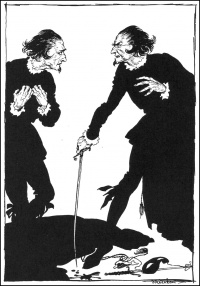A chronology of the discovery of the unconscious in the 19th Century
From The Art and Popular Culture Encyclopedia
|
Related e |
|
Featured: |
This page is a wikified version of the chronology of the discovery of the unconscious in the 19th century[1] by Jeffery Howe.
1774 F.A. Mesmer, demonstrations of Mesmerism, or animal magnetism.
1781 Henry Fuseli, The Nightmare; painting.
1799 Francisco de Goya, The Sleep of Reason Produces Monsters; Caprichos, pl. 43; etching.
1819 Arthur Schopenhauer, The World as Will and Idea; philosophy
1822 Theodore Gericault's portraits of the insane for Dr. Georget; paintings.
1836 Robert Macnish, The Philosophy of Sleep; psychology.
1839 Edgar A. Poe, "William Wilson;" short story about double personality.
1842 James Braid, Scottish physician, coins term Hypnotism.
1843 Gustave Courbet, Self-Portrait as a Desperate Man; painting.
1845 Edgar A. Poe, "The Facts in the Case of Mr. Valdemar;" short story about mesmerism.
1846 Carl Gustav Carus, Psyche. Zur Entwicklungsgeschichte der Seele.; psychology.
1848 Discovery of Spiritism in Hydesville, New York, by the Fox family.
1857 Victor Hugo, spiritist drawings, seances. Justinus Kerner, Klecksographien; spiritist drawings.
1861 Hervey de Saint-Denis, Les Rêves et les moyens de les diriger; psychology. Alphonse Maury, Le sommeil et les rêves; psychology.
1862 Gotthilf Heinrich von Schubert, Die Symbolik des Traumes; psychology.
1868 Eduard von Hartmann, The Philosophy of the Unconscious; psychology.
1872 Friedrich Nietzsche, The Birth of Tragedy; philosophy.
1876 Stephane Mallarme, "L'après-midi d'un faune;" poetry.
1879 Odilon Redon, Dans le Rêve; album of lithographs.
1881 Max Klinger, Paraphrases about the Finding of a Glove ; etchings.
1882 Society for Psychical Research founded in London. J.M. Charcot presents lecture to French Academy on Hypnotic therapy for hysterics. Hypnosis is rehabilitated as a medical technique.
1885 Karl, Freiherr von Prel, The Philosophy of Mysticism; philosphy. Sigmund Freud studies with Charcot in Paris; Max Nordau also studies with Charcot this year.
1886 Robert Louis Stevenson, Strange Case of Dr Jekyll and Mr Hyde; novel. Guy de Maupassant, "Le Horla," short story.
1888 Paul Gauguin, Vision After the Sermon: Jacob Wrestling with the Angel; painting. Edouard Dujardin, Les Lauriers sont coupés; novel with first direct interior monologue.
1889 First International Congress of Hypnotism in Paris. Among those attending were Charcot and Sigmund Freud. Fernand Khnopff, Memories; painting.
1891
- Odilon Redon, Songes; album of lithographs.
- Fernand Khnopff, I Lock the Door Upon Myself[2]; painting.
- George du Maurier, Peter Ibbetson; novel about dreams.
1894 George du Maurier, Trilby; novel about hypnotism. August Strindberg, "The New Arts, or the Role of Chance in Artistic Creation;" essay proposing the use of chance effects as an expression and analogue of the unconscious.
1895 Josef Breuer and Sigmund Freud, Studies on Hysteria; psychology.
1897 Dr. Paul Chabaneix, Le Subconscient chez les artistes, les savants et les ecrivains; psychology.
1900 Sigmund Freud, The Interpretation of Dreams; psychology. Fernand Khnopff photographed in front of his altar to Hypnos[3]. (date approximate)
1901 Annie Besant and Charles Webster Leadbeater. Thought Forms; theosophy.
1902 August Strindberg, A Dream Play; drama.
1907
Emile Magnin, L'Art et l'Hypnose; hypnotic trance as a key to artistic creation, with documentation of experimental performances.



